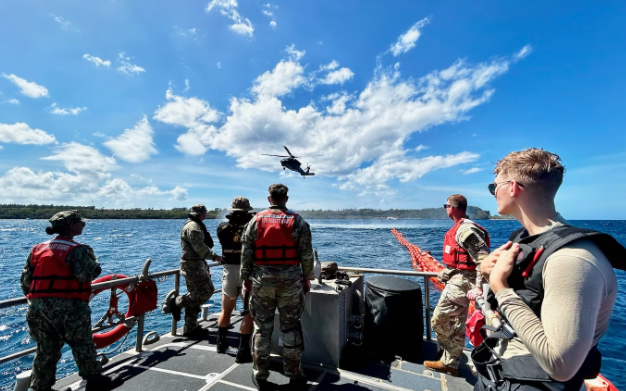The Coast Guard Station Apra Harbor's 45' response boat-medium supported an intricate cast and recovery training exercise in Apra Harbor earlier this month.
The vital training involved collaboration with the Army Scouts from the 3rd Squadron, 4th U.S. Cavalry Raiders of the 3rd Infantry Brigade Combat Team (IBCT), 25th Infantry Division, and the U.S. Navy Helicopter Sea Combat Squadron 25 — the "Island Knights," based at Andersen Air Force Base.
"The purpose of the training was to certify seven new helocast masters. Using helicopters greatly expands the distance a reconnaissance boat crew can conduct operations. The helocast exercise surpassed all expectations and greatly contributed to our ability to train, fight when called upon, and win in the Pacific," said Sgt. 1st Class Brendan Spangler of the U.S. Army Comanche Troop 3rd Squadron 4th Cavalry Regiment.
The specialized cast and recovery operations, essential for maritime stability and security, saw the Island Knights of HSC-25 expertly pilot the MH-60S Knighthawk helicopter, allowing the Scouts to deploy from the helicopter. They were then recovered from the water by the U.S. Coast Guard crew. The rescue boat crew also served as a safety resource for the exercise, ready to support in any emergency situation. This exercise underscores the seamless interoperability and mutual support among the U.S. military branches, enhancing readiness and effectiveness in various environments.
“As the only forward-deployed naval forces HSC expeditionary squadron, HSC-25 is fortunate to integrate and train with our joint partners in the region,” said Cmdr. Neil Toohey, commander, Helicopter Sea Combat Squadron 25. “Exercises like this help maintain our advantage and highlight the unique capability of naval rotary wing aviation. I’m proud of the collaborative efforts between HSC-25, U.S. Coast Guard Forces Micronesia, and the 4th Cavalry Regiment to shape a more agile and responsive joint force.”
The support available from partners in Guam led the Scouts to travel from Hawaii for the opportunity. The training reinforces the capability of forces to operate cohesively and enhances the interoperability among the U.S. military branches. Such collaborations are crucial for crisis response, cooperation, and maritime security, contributing to regional stability and safety.
"This joint effort exemplifies the commitment of the U.S. Coast Guard to work cooperatively with the Army and Navy to foster a secure, prepared, and resilient force," said Capt. Nicholas Simmons, commander, Coast Guard Forces Micronesia/Sector Guam. "One of our 11 missions from Congress is defense readiness. Supporting the training requirements of our partners reflects our dedication to that strategic partnership and the collaboration necessary for addressing shared challenges to ensure regional maritime safety and security."
Located aboard Naval Base Guam, Coast Guard Station Apra Harbor crews play a crucial role in maritime safety and security through its primary missions of search and rescue, law enforcement, and protecting living marine resources and critical infrastructures. Tasked with locating and assisting individuals in distress at sea, enforcing maritime laws to prevent illegal activities such as smuggling and illegal fishing, and safeguarding marine habitats and critical resources like ports and maritime transportation systems, the station crew exemplifies the service's commitment to maintaining safety and legal order in its operational waters. As an integral part of U.S. Coast Guard Forces Micronesia/Sector Guam, Station Apra Harbor also engages in joint operations and exercises with other agencies, significantly enhancing their capabilities to fulfill these essential missions.




